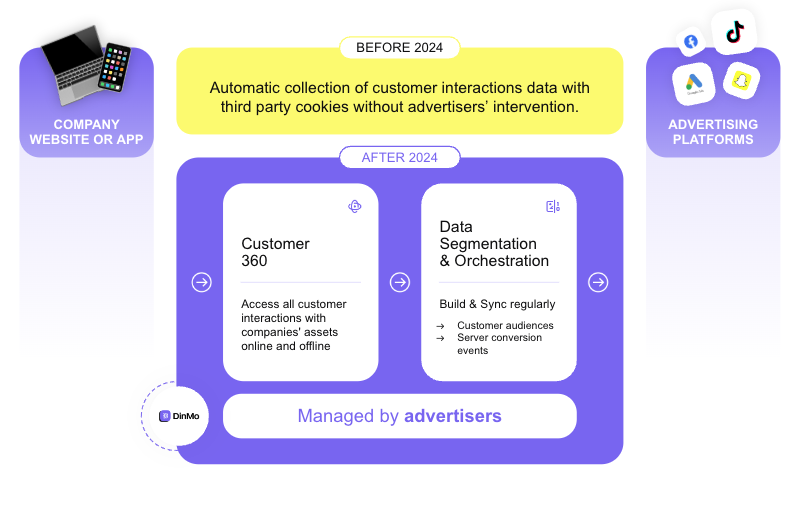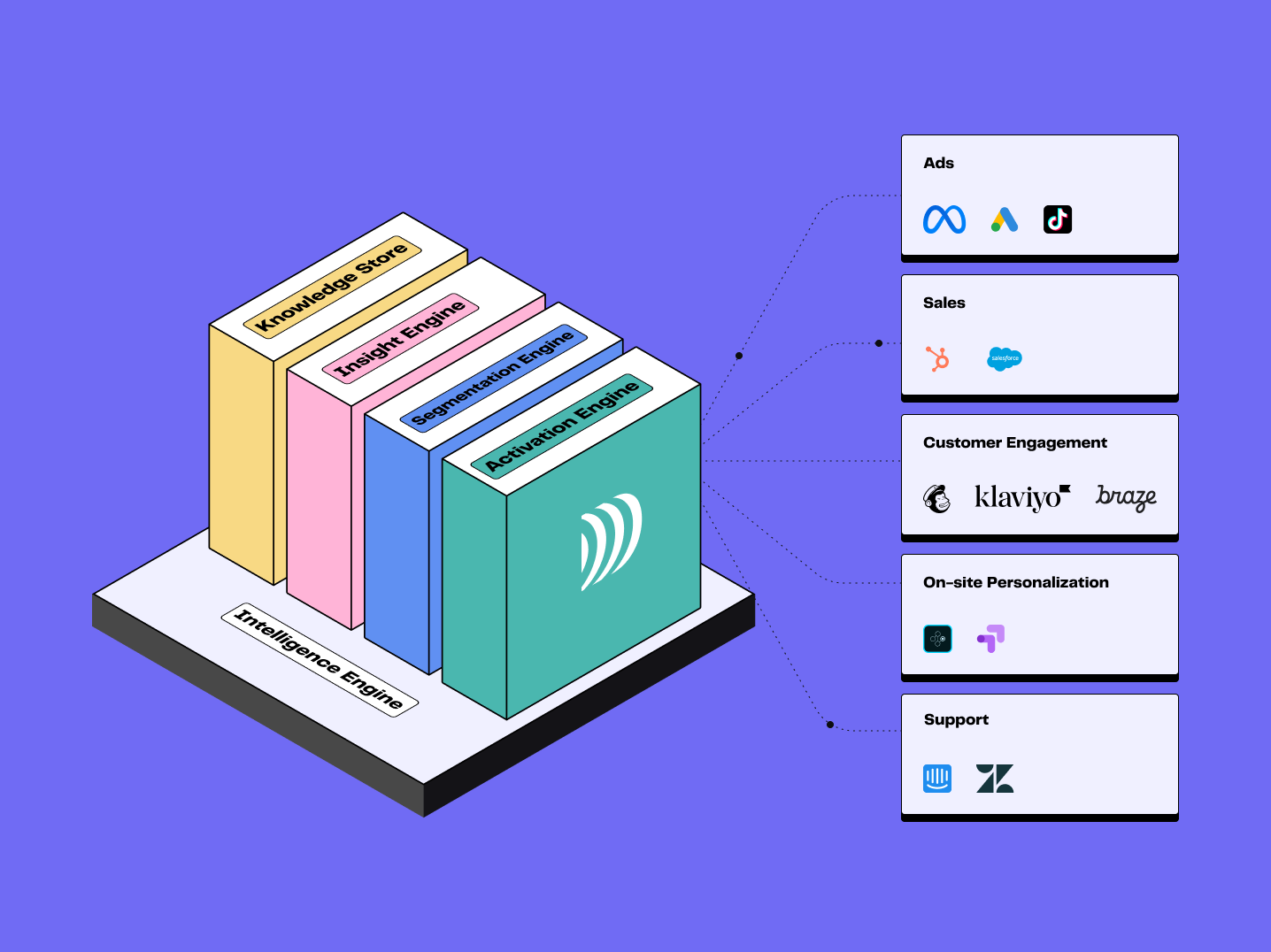Identity resolution plays a crucial role in developing unique customer profiles by analysing and associating data collected through various touch points, channels and systems. Utilising both deterministic and probabilistic matching techniques, it leverages multiple identifiers from different devices to create a comprehensive view.
This process is fundamental for refining marketing strategies, ensuring privacy compliance, and delivering a personalised customer experience.
This unification process can be achieved through software, particularly Customer Data Platforms (CDPs). These platforms serve as a central data base that integrates information from multiple devices and channels, enabling businesses to create single, unified profiles for each consumer.
Key takeaways:
Identity resolution links multiple identifiers to the same individual. It is the technical process used to build a 360° customer view from data collected across different channels.
It enhances personalisation, targeting, and customer journey analysis — all while respecting user privacy.
There are two main approaches to identity resolution: deterministic (based on tangible information such as email) and probabilistic (based on signals like IP address).
👉🏼 In this article, we define what identity resolution is and explain why it is essential for your marketing strategy.
What is identity resolution?
Identity resolution is a process that involves creating a single, unique and targetable profile for each customer by analysing and linking data from multiple touch points, channels and systems. Touch points encompass various ways a consumer interacts with your brand, including the website, mobile app, social media, emails, and more digital channels.
The foundation of identity resolution relies on the ability to identify and associate different identifiers corresponding to a single person, such as their email, cookie ID, and device identifier, among others. This process ensures accurate matching of customer identities across multiple devices and channels, enhancing both business insights and user experiences.
One key aspect of identity resolution is the use of an identity graph, which acts as a data warehouse connecting a customer's profile to all known identifiers such as physical addresses, email addresses, phone numbers, and device IDs. This graph enables a comprehensive view of the consumer journey, facilitating enhanced analytics and personalised marketing.
Identity resolution enables the creation of a 360-degree view of any consimer (also known as Customer 360), which can be utilised in any system or marketing campaign. This holistic customer profile is crucial for effective marketing and business strategies, allowing marketers to work on detailed profiles and comprehensive data.
Why is ID resolution necessary in marketing?
Successfully communicating with customers is not easy:
The advertising landscape is saturated, with each person exposed to an average of 1,200 messages per day.
The number of possible touch points is increasing, making it challenging to maintain a consistent message across all channels.
Despite this, consumers are increasingly demanding, seeking an effective and transparent omnichannel relationship and greater personalisation. Identity resolution helps in creating a consistent user experience across various touch points and channels, ensuring that each individual's interaction with the brand is seamless and personalised.

Customer 360 generation
Identity resolution aids in achieving data onboarding, which involves transferring offline data to an online environment to create a comprehensive customer profile and facilitate personalised marketing efforts. This helps in matching offline identifiers with online user profiles, ensuring a unified view of the consumer across all channels.
The ability to generate such a 360-degree view is essential for effectively segmenting the audience, refining targeting, and personalising communication approaches while ensuring consistency across all channels. Indeed, identity resolution is crucial for enabling deeper product insights and accurate understanding of user journeys, which are essential for delivering personalised experiences and ensuring better customer engagement. It allows marketers to create accurate, individualised profiles of customers.

Customer 360, centralising all customer data
Improved decision making through data
Access to a comprehensive representation of customers enhances the understanding of their behavior, satisfaction level, loyalty, and added value. This becomes a powerful lever to refine marketing strategies, accurately evaluate return on investment, identify growth opportunities, and anticipate potential risks. Proper data management and analytics are key to this process.
Holistic understanding of the customer journey
With cross-channel tracking, identity resolution allows for the analysis of the complete customer journey, highlighting their motivations, potential hesitations, and obstacles encountered. This broad perspective enables the orchestration of a smooth and transparent user experience, finely adjusted at each engagement stage, from awareness to loyalty.
Furthermore, a robust identity resolution solution can equalise offline and online experiences. This is highly beneficial for businesses that operate both physical stores and online storefronts, allowing them to send personalised offers across channels like email, push notifications, and even physical coupons to drive purchases.
Ensuring security and regulatory compliance
Besides creating these comprehensive profiles, having an effective identity resolution solution is invaluable for data governance and privacy compliance. With stricter regulations such as GDPR and CCPA, marketers must ensure data is consolidated and managed correctly to avoid privacy breaches and compliance issues.
In full compliance with personal data protection standards, identity resolution ensures security for both customers and brand reputation. In a regulatory environment marked by the phasing out of third-party cookies, it relies on first-party data collected from consumers, enabling accurate user identification while preserving the relevance and effectiveness of marketing campaigns. Privacy remains a fundamental concern in this process.

Companies will have to manage the centralisation, segmentation, and orchestration of their data.
Enhanced predictive modeling
Identity resolution is key to obtaining a broad and reliable set of customer data from any source, reflecting the consumer journey. This data warehouse is essential for building a learning base for machine learning and artificial intelligence algorithms. Analytics and better customer knowledge lead to better detection of behavioral and transactional patterns, resulting in improved predictions (such as lookalikes, churn risk, additional expected CLV, etc.).
How does identity resolution work?
There are two types of identity resolution: deterministic matching and probabilistic matching.
Deterministic resolution
✅ Deterministic identity resolution relies on unique and reliable identifiers. These ensure a direct match between an identifier and a customer (e.g., email, phone number, social media account, etc.).
The advantage? Precise matching every time. This approach is well-suited when your users willingly log in or register on your different online channels. However, when you lack first-party data to identify a person, you miss out on certain information and may only have a partial view of their customer journey.
Probabilistic resolution
🎲 Probabilistic resolution relies on complex statistical algorithms to assess the likelihood that a specific identifier belongs to a particular consumer. This may include a cookie ID, device identifier, IP address, or fingerprinting techniques.
This method increases the chances of accurate entity matching across multiple digital touchpoints and channels. It also enables broader coverage of customers, including those who have never provided identifiable personal data (never logged in, for example).
However, there is always a risk of misidentifying the individual. This type of matching relies on sophisticated data modeling techniques. It is the method of choice for situations where first-party data is scarce or when wide dissemination across multiple channels is a priority.
Which method to choose?
Of course, identity resolution is not black and white. It is possible to combine deterministic and probabilistic approaches to be as comprehensive and accurate as possible in recognising your consumers. You can choose a degree of certainty (e.g., 80%), beyond which you accept the risk of an individual being misidentified. These hybrid models help businesses achieve a higher resolution in customer profile matching.
Often, Customer Data Platforms (CDPs) are used to centralise, transform, and aggregate data from all sources to orchestrate this process. They also allow the implementation of marketing use cases that stem from a Customer 360 view, ensuring accurate cross-device user matching and comprehensive analytics.
Conclusion
Identity resolution proves to be crucial for digital marketing, offering a complete 360-degree view of each consumer. It opens the door to advanced analysis, informs data-driven decision-making, provides a comprehensive view of the customer journey, and addresses security and compliance challenges head-on. The integration of multiple data sources into a single platform is key to achieving this.
For businesses ready to embrace identity resolution within their digital marketing strategy, Customer Data Platforms (CDPs) greatly facilitate the process. These platforms help in creating accurate, matched profiles that ensure consistency and precision across marketing efforts.
🌟 If you want to learn more about our identity resolution methods and how our modular CDP approach can help you, feel free to contact us.


















